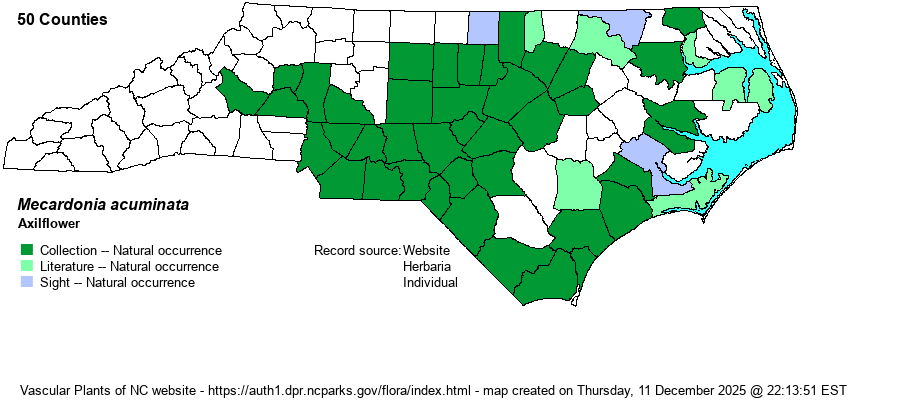| Author | (Walter) Small | |
| Distribution | Throughout the eastern half of the Piedmont and much of the western and central Coastal Plain, including the Sandhills region. Absent from the Mountains and much of the western Piedmont, and scarce to locally absent in the far eastern Coastal Plain. The gap in the west-central Coastal Plain seems like an anomaly of collecting.
This is a Southeastern species, ranging from DE and southeastern KS, south to southern FL and central TX. It is mostly absent from the Appalachians.
| |
| Abundance | Fairly common to frequent in the eastern half of the Piedmont and the far western Coastal plain. Fairly common at least locally in the central Coastal Plain. Very rare but increasing in the northeastern Coastal Plain. Extremely rare west of Person, Guilford, Rowan, and Mecklenburg counties, and absent in the Mountains. | |
| Habitat | This is a wetland species of a great variety of habitats, including seasonally wet soils. It grows in openings in swamps and bottomlands, in ditches, on marsh edges, at pools, in seeps, and in pine savannas and ecotones. | |
| Phenology | Blooms from July to October, and fruits shortly after flowering. | |
| Identification | This is a small to medium-sized, erect herb with a mostly unbranched to sparingly branched stem to about 1 foot tall. It has scattered pairs of opposite leaves along the stem, as in the Gratiola and Lindernia species, and might be confused with members of those genera. However, in this species the leaves are clearly wider toward the tip, being oblanceolate, tapered to the base, and minutely serrated toward the tip; each is about 1.3 inches long but only 1/4 as wide. Leaves in those other genera are wider toward the base or are elliptic to linear; most are also smaller than on Mecardonia. From many of the leaf axils grow the flowers on noticeably long pedicels, each stalk being nearly 1-inch long and ascending. The flowers are about 2/5-inch long, tubular, and with purple lines on the lower lip. When in bloom, the species is conspicuous by the many white flowers well away from the stem and usually on ascending stalks. Mostly however, you should identify this slender wetland herb by its paired, oblanceolate leaves. Thankfully, observers in the middle parts of the state should encounter this species fairly often, less so toward the coast. | |
| Taxonomic Comments | Weakley (2018) indicates that the nominate variety -- M. acuminata var. acuminata -- is the one present in NC.
| |
| Other Common Name(s) | Mecardonia | |
| State Rank | S4 | |
| Global Rank | G5 | |
| State Status | | |
| US Status | | |
| USACE-agcp | FACW link |
| USACE-emp | OBL link |

